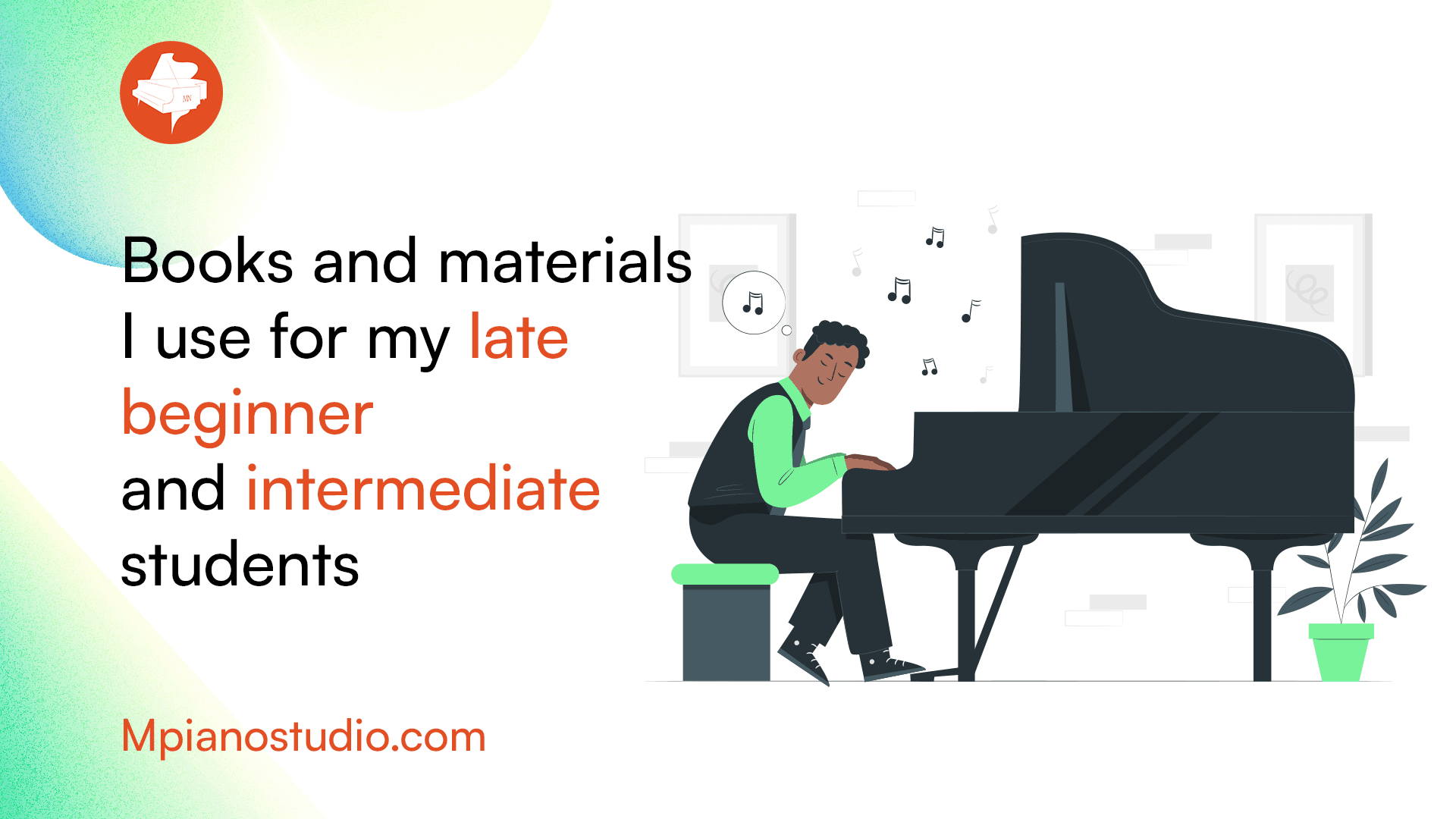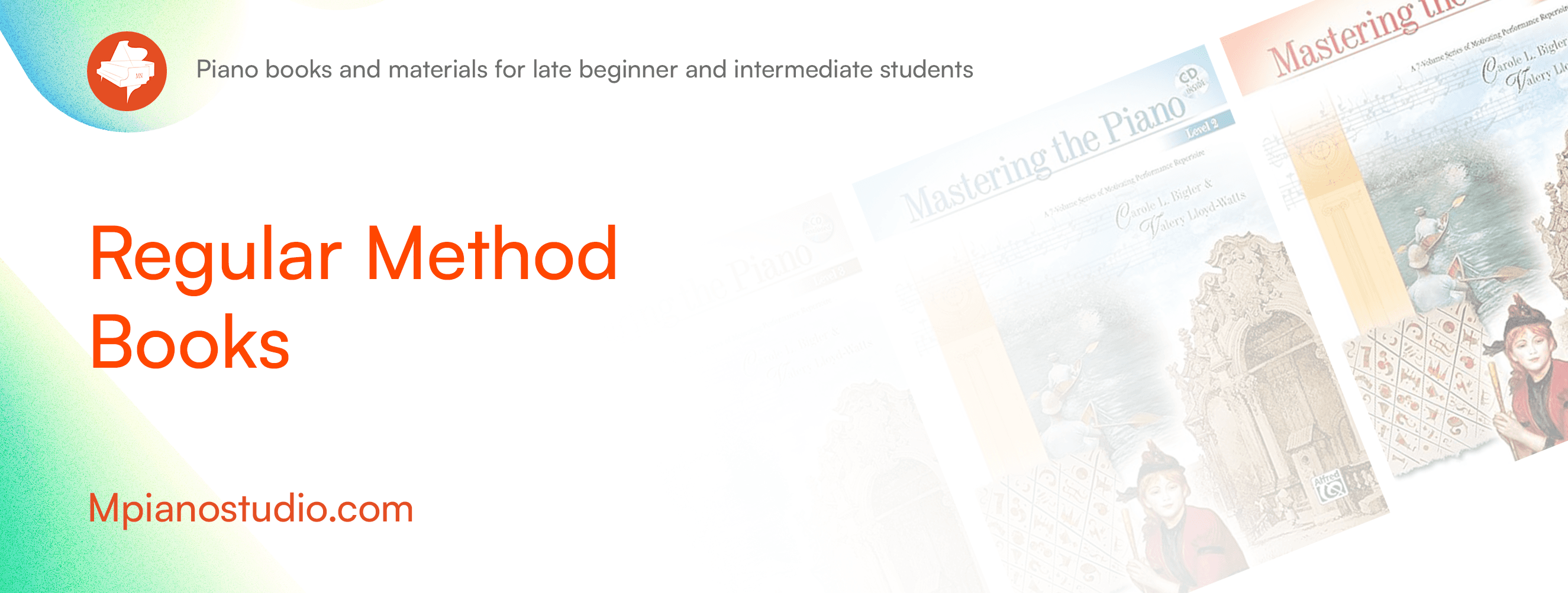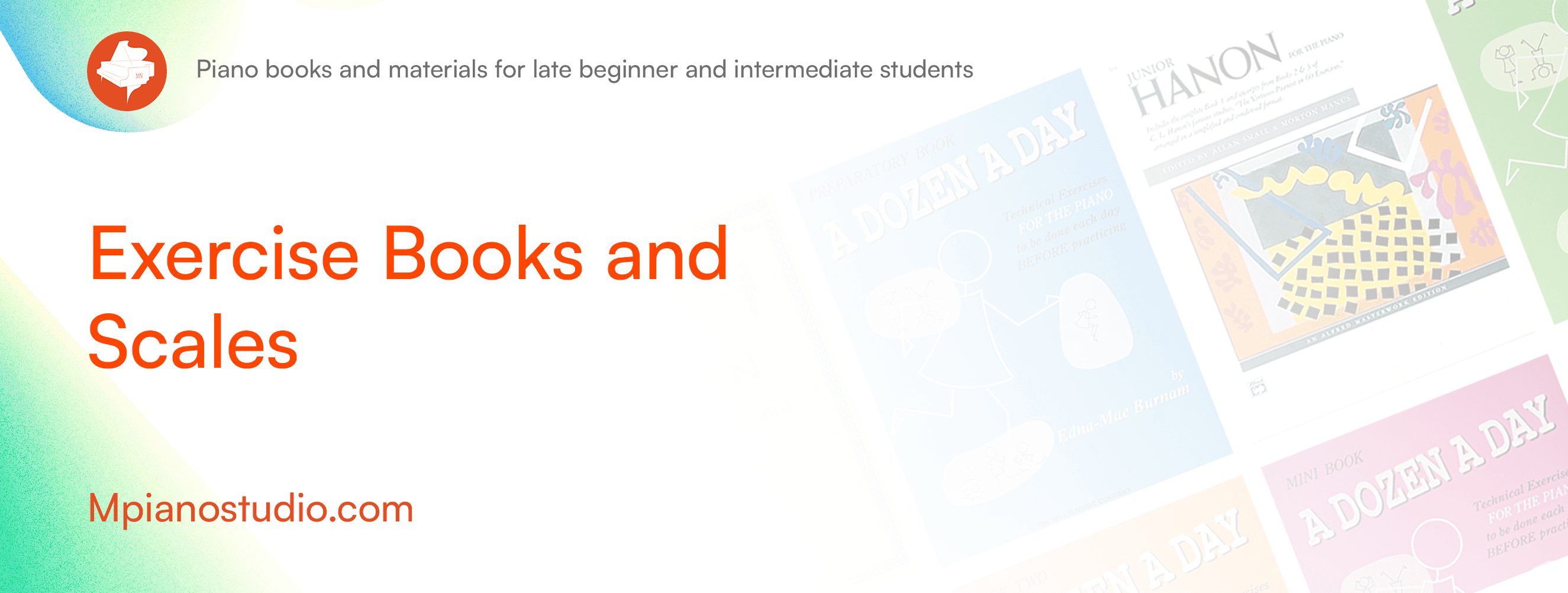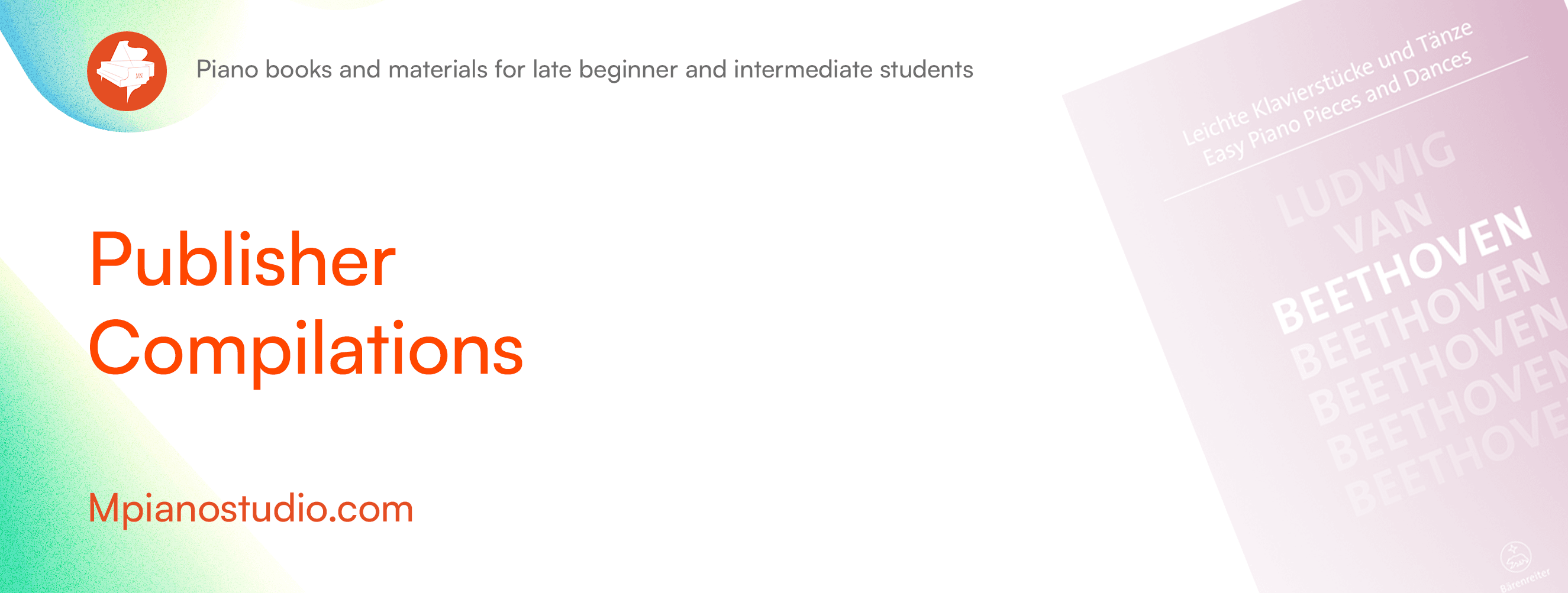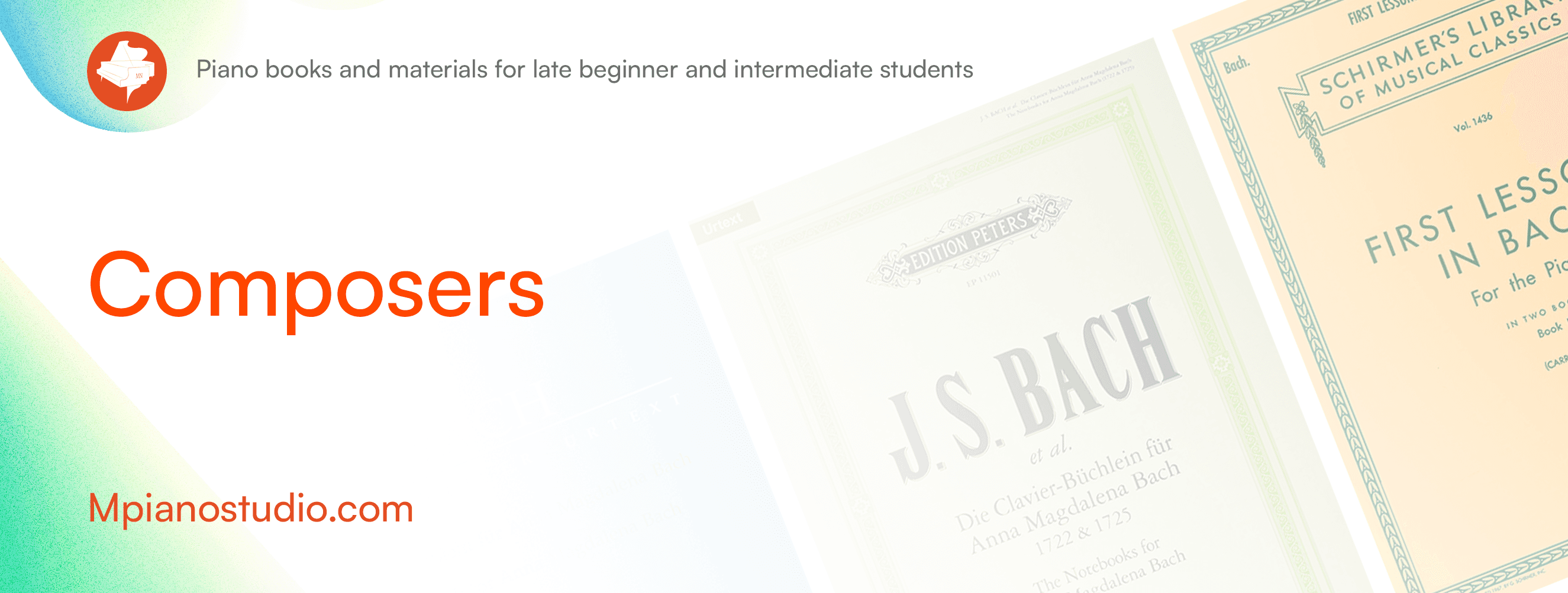Feb 8, 2024
10 min read
Meyer Nam
It can be a bit difficult to determine when a pianist transitions from a beginner stage to an intermediate stage. Some books are marketed toward intermediate pianists, yet I would view them as material for middle to late beginners.
In this article, I wanted to cover the books I use after students finish their primers (books that beginners first use to learn piano). This will be a lengthy article that will have a lot of material to read. Again, I do not use every book on this list for every student. This is just a summation of basically every book I have used so far. This list will be updated as I research and teach with more and more books.
All Amazon links in this article use my Amazon affiliate links. By using and buying from these links, I receive a small percentage as commission. No extra cost will be incurred to you for using these links.
Regular Method Books
Mastering the Piano series
One of the very first books I used in my career was the Mastering the Piano series published by Alfred. The difficulty of pieces scales well throughout the book, and many are appropriate for performing. Book 1 is a compilation of elementary pieces from composers who wrote for elementary students such as Alexander Reinagle, Cornelius Gurlitt, and Ferdinand Beyer. Book 2 has pieces from more well-known composers such as Burgmuller, Streabbog, JS Bach, Clementi, and Schumann. Book 3 is where well-known repertoire starts to appear, such as Chopin’s A Minor Waltz, CPE Bach’s Solfeggio in c, and the third movement of Clementi’s 3rd sonatina. I normally stop using these books after learning material in books 2 and 3, in which I will then begin suggesting students purchase actual scores.
Mastering the Piano, Book 1: A 7-Volume Series of Motivating Performance Repertoire
Mastering the Piano, Book 2: A 7-Volume Series of Motivating Performance Repertoire
Mastering the Piano, Book 3: A 7-Volume Series of Motivating Performance Repertoire
Neil A Kjos Library
One of my transfer students brought over a series of books by Keith Snell which she had used with a previous teacher. Each level from this series has a few different books on various topics and eras, from etudes (studies) to theory, to sightreading, to pieces from particular eras. It is a business model I don’t particularly like because it seems impractical to purchase all these books. The only three books I’ve used and purchased are the etude books, Baroque and Classical books, and the Romantic and 20th-century books from different levels. Keith Snell does publish a compilation book that uses a few pieces from each of those three books for each level.
I have been thoroughly enjoying teaching material from these books to young beginners after they’ve finished their primers. Depending on their level after finishing their primer, I may skip the preparatory level and skip right to level 1. I started my middle school brother on piano with the preparatory level book, and he is doing quite well. I’m not sure I would use these books as a primer, however. There are some pieces in these books that I could not find in even urtext editions. Two examples would be Haydn’s Quadrille in C Major, and Beethoven’s Village Dance, two pieces that are used in NYSSMA level 1. Three pieces from Kabalevsky’s Op 39 Pieces for Children are in the Romantic and 20th Century book from the Preparatory Level, perfect for the NYSSMA level 1 requirement as they require three pieces from the Op 39 collection to be eligible.
Preparatory Level
GP600 - Piano Repertoire: Baroque & Classical Preparatory Level
GP620 - Piano Repertoire - Romantic & 20th Century - Preparatory Level
GP640 - Piano Repertoire - Etudes - Preparatory Level (Neil A Kjos Piano Library)
Level 1
Level 2
GP622 - Romantic and 20th Century - Piano Repertoire - Level 2
GP452 - Essential Piano Repertoire of the 17th, 18th, & 19th Centuries Level 2
Suzuki
I am not a Suzuki certified teacher and have no interest in specializing as such. However, I do enjoy teaching the pieces in these books. Level 1 has some performance-oriented traditional pieces, such as Lightly Row, Go Tell Aunt Rhody, and Cuckoo. I am quite familiar with the NYSSMA curriculum, and there are two pieces in the first Suzuki book that are eligible for the first level of NYSSMA. The second and third Suzuki books shift from arranged traditional folk songs to classical pieces.
Exercise Books and Scales
There are only two exercise books that I would suggest using for this level, Dozen a Day, and Hanon. Dozen a Day is very friendly towards beginners and has a few books. They are simple yet very effective in teaching technique, one concept at a time.
I would start Hanon exercises with people once they reached the late intermediate level. And even at that point, Hanon should be taught carefully. Alfred has a Junior Hanon book that I rarely use but is more suitable for the more amateur pianist than the full book. However, I generally suggest the full book to most students.
Dozen A Day
Preparatory Book A Dozen a Day Preparatory Book, Technical Exercises for Piano (A Dozen a Day Series)
For scales and arpeggios, I like to use Alfred’s book filled with scales, chords, arpeggios, and cadences. While each scale only covers two octaves, it should be trivial for students and teachers to teach fewer or more octaves. It is very easy to navigate and to use. Advanced students would most likely benefit more from using Part 2 of Hanon.
Composers
The books I prefer to use are urtext editions, which the aforementioned books are not. The following books in this list are from classical composers directly. I’d like to add a small disclaimer about editions. There are many editions and publishers that are in the industry, and it can be overwhelming to choose one in particular. I will add up to two links for each composer, the best edition (in my opinion) and the edition with the most value. In some cases, there may be only one good edition. Of course, this is subjective. There are debates on this topic, but I won’t go over that in this article.
Bach, J.S.
Anna Magdalena Notebook
The Anna Magdalena Notebook is famous for containing the popular Minuet in G by Christian Petzold. This book contains equally amazing pieces composed by JS Bach and his contemporaries for his wife, Anna Magdalena. This is such an amazing resource to have for teachers and students alike. The pieces are of varying difficulty, and this book can be used for late intermediate as well as late beginner students.
Notebook for Anna Magdalena Bach 1725 (Piano with fingerings)
The Notebooks for Anna Magdalena Bach 1722 & 1725 for Piano (Selection): Sheet (Edition Peters)
First Lessons in Bach, Books 1 and 2
A very popular book that most intermediate pianists have is Schirmer’s collection of easier Bach pieces. However, I believe that the Anna Magdalena Notebook is a more desirable book to have and practice from. It also has incorrect information, as not all the pieces are composed by Bach. Schirmer’s printing and spacing are usually of poor quality as well and I can’t recommend Schirmer editions easily. However, this book does come with an affordable price. I may recommend this book for that reason alone.
First Lessons in Bach - Book 1: Schirmer Library of Classics Volume 1436 Piano Solo
First Lessons in Bach - Book 1: Schirmer Library of Classics Volume 1436 Piano Solo
Inventions
Bach’s Inventions are the perfect pieces for the intermediate pianist. Bach wrote these for his students to play and learn from. These pieces are a perfect bridge from the easier Bach pieces to the harder pieces, such as the suites, and the Well-Tempered Klavier. The linked book combines the Inventions and Sinfonias, and even though there are cheaper editions, I believe this is one of the few books that is worth spending more for.
Ludwig van Beethoven
Bagatelles
Beethoven’s bagatelles are perfect for early intermediate students to play separately, or for late intermediate students to perform each opus as a set. While most know Beethoven for his dense sonatas, these lighter pieces are a good contrast to bring to a recital. I wouldn’t recommend most students to purchase the complete set of bagatelles unless they are eager to learn most of them. There are a few editions that sell each opus separately, but they are seven to nine dollars each. I would rather purchase a better edition that has them all for a cheaper price overall, which is Henle.
Piano Concerto 1
Everyone knows of Beethoven’s difficult third and fifth piano concerti. However, his first concerto is fitting for late intermediate students to perform. This is early Beethoven, so the concerto has elements from Mozart and Haydn’s compositions. It is a little expensive, but the Henle edition is worth the price. The piece is also perfect for intermediate students to submit for concerto competitions.
Burgmuller, Johann Friedrich
25 Easy and Progressive Studies for the Piano, Op 100
Burgmuller’s Op 100 works are very popular. Some are featured in the method books listed above. I find that these are excellent to teach, as they are etudes, but aren’t boring to listen to or to play. They are an excellent set of pieces to perform. Additionally, they are in NYSSMA Level 3.
Chopin, Frederic
Nocturnes
Waltzes
Two of the most important sets to have are the Chopin Nocturnes and Waltzes. They are mandatory to have, regardless of level, and are standard repertoire. I can easily recommend most pianists study most of his easier waltzes and nocturnes and play the more difficult ones later. The annoying thing about the best edition of Chopin's pieces is that they often separate the set into pieces that were published during his lifetime and pieces that were published after he passed. Therefore, instead of one book for Waltzes, it becomes two. I believe it is worth the cost to have both of these, however. “A” books are books that contain pieces during his lifetime and “B” books are books that contain pieces that were published after he passed away.
Haydn, Joseph
Piano Concerto in D Major Hob XVIII:11
Haydn’s D Major piano concerto is one of his most famous compositions and is popular in its genre. It is one of the easiest concertos, yet students enjoy playing it as its spirited and catchy theme is fun to practice and play. It is no easy piece, however, and is perfect for the intermediate student.
Kabalevsky, Dmitri
Pieces for Children, Op 27
Pieces for Children, Op 39
Kabalevsky’s easy pieces for children are popular in how simple the pieces are and the sheer number of pieces. This collection is perfect to study for those who want to learn pieces that don’t strictly follow traditional harmony and yet aren’t atonal. Two of the links are on each book and one with both works.
Mozart, WA
Notebook for Nannerl Mozart
Like Bach’s notebook for his wife, Nannerl Mozart received a book compiled of pieces composed by Leopold Mozart, her father, and Wolfgang, her brother. It is interesting to see Mozart’s earliest works in this collection. Also like the Anna Magdalena Notebook, the pieces are of various difficulty.
Piano Concerto 21 and 23
Mozart’s Piano Concerto is one of his most famous concerti, along with the other on this list, number 23. They are not as difficult as the d minor concerto but are just as important to learning Mozart concertos. These are geared more toward the late intermediate students and require an accompanist for performance. I can only recommend the Henle or Barenreiter edition for these concerti.
Prokofiev, Sergei
Music for Children, Op 65
A criminally underrepresented set of works is Prokofiev’s Op 65 Music for Children. I’ve had the pleasure of having one of my adult students prepare a piece from this set for my first annual recital. Even though it is named “Music for Children,” the pieces are not very childish in terms of the music or the technique. A few select pieces from this set are eligible for NYSSMA level 3.
Schumann, Robert
Album for the Young, Op 68
One of Schumann’s most important works is his Op 68 Album for the Young. I find these pieces are excellent to teach and play, and the range of difficulty is massive. Some pieces are featured in method books such as the Mastering the Piano books, and the Suzuki books. This book is important to me, and I am excited to teach more pieces from this book.
This list will be updated as I incorporate more and more books into my teaching repertoire. I will also write reviews on each series and book. Please keep in mind that not every book is for everyone. As a teacher, I determine the starting book(s) based on a multitude of factors.

